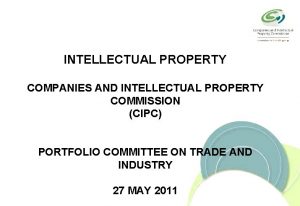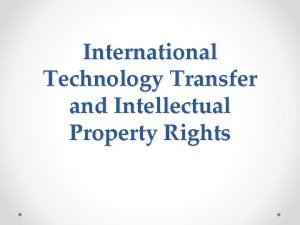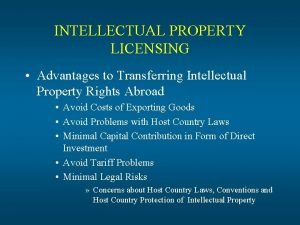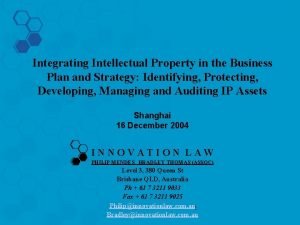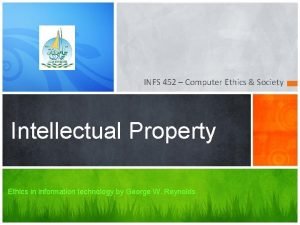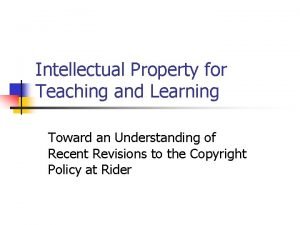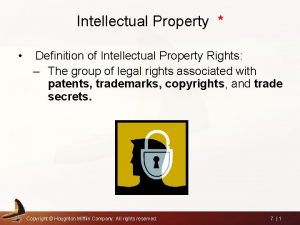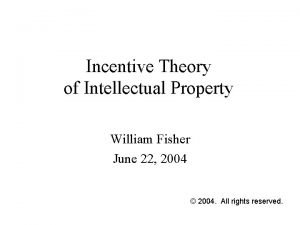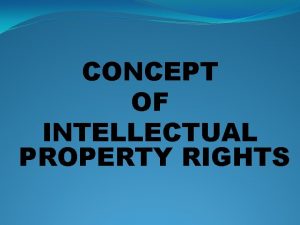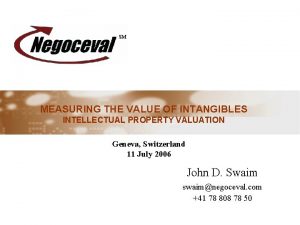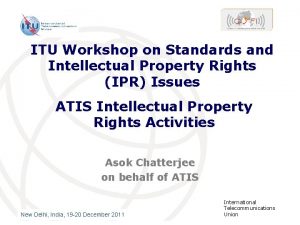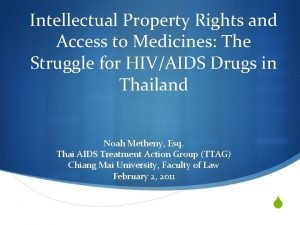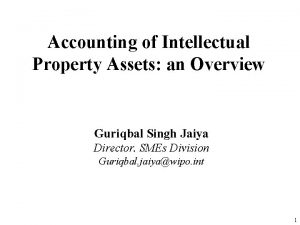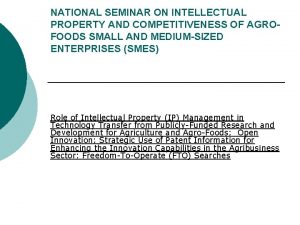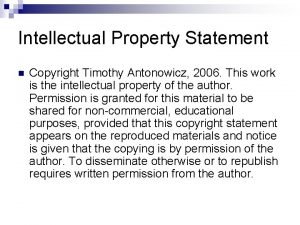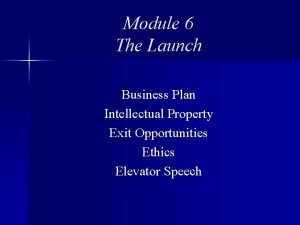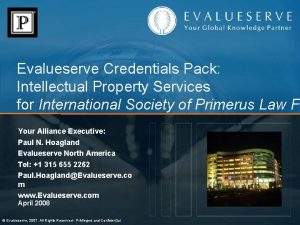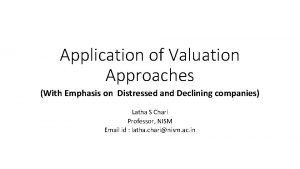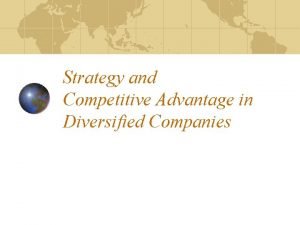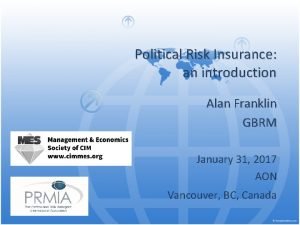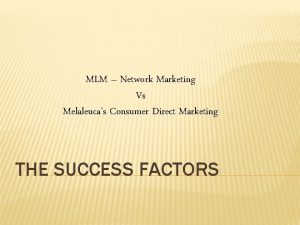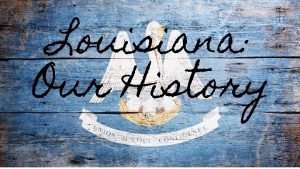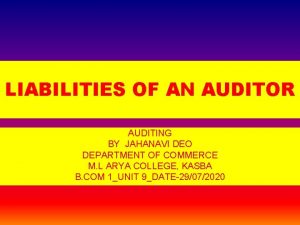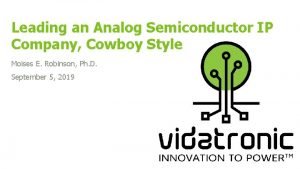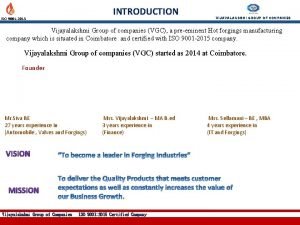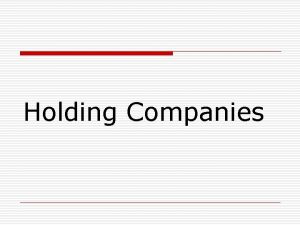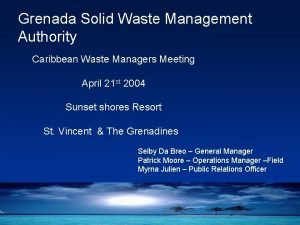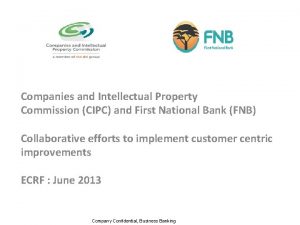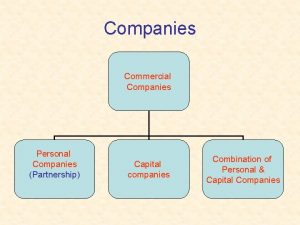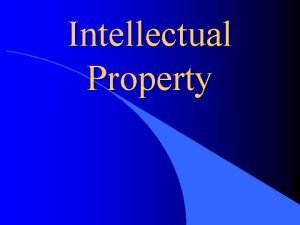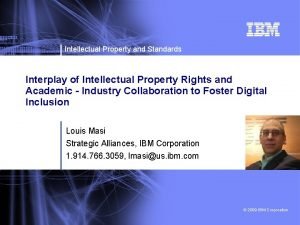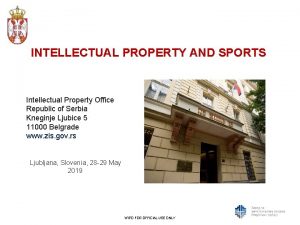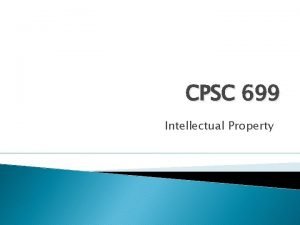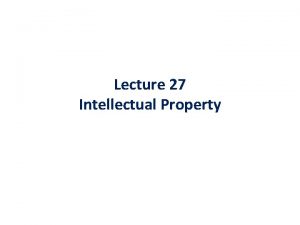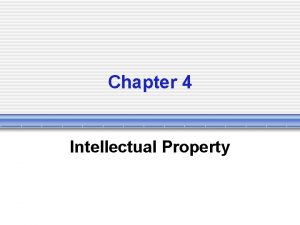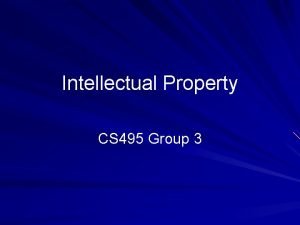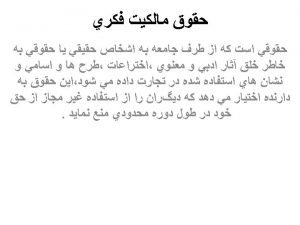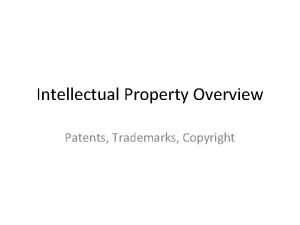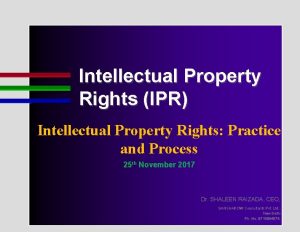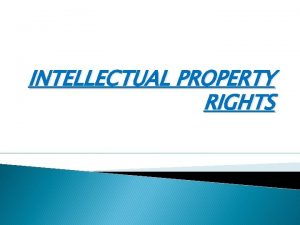INTELLECTUAL PROPERTY COMPANIES AND INTELLECTUAL PROPERTY COMMISSION CIPC














































- Slides: 46

INTELLECTUAL PROPERTY COMPANIES AND INTELLECTUAL PROPERTY COMMISSION (CIPC) PORTFOLIO COMMITTEE ON TRADE AND INDUSTRY 27 MAY 2011

PRESENTERS q Astrid Ludin, Commissioner q Rory Voller, Deputy Commissioner q Fleurette Coetzee, Senior Manager: Trade Marks q Kadi Petje, Senior Manager: Copyright q Elena Zdravkova, Senior Manager: Patents & Designs

OVERVIEW q Introduction q Trade Marks q Copyright q Patents and Designs q Conclusion q Questions

INTRODUCTION q Companies and Intellectual Property Commission (CIPC) is the amalgamation of the Companies and Intellectual Property Registration Office (CIPRO) and the Office of Companies and Intellectual Property Enforcement (OCIPE). q CIPC is put in place to deliver on the new Companies Act (Act 71 of 2008)’s mandate. q CIPC will act independently with a focus on the registration and maintenance of corporate entities and intellectual property. q As part of its functions, CIPC will also include education and

INTRODUCTION Intellectual Property Structure: Commissioner Deputy Commissioner Registration and Maintenance of Corporate Entities & Intellectual Property Complianc e, Education, Awareness and Training Complaints, Enforceme nt and Investigatio ns Litigation and Corporate Legal Regulatory Services Research, Analysis and Knowledge Manageme nt Advocacy, Policy Coordinatio n and Stakeholde r Manageme nt Corporate Manageme nt Finance

INTRODUCTION Intellectual Property Structure: Registration and Maintenance of Corporate Entities and Intellectual Property Corporate Entities Intellectual Property

INTRODUCTION Intellectual Property Structure: Intellectual Property Trade Marks Copyright Senior Manager Senior Deputy Registrar Staff Compliment = 78 Staff Compliment = 3 Patents & Designs Senior Manager Deputy Registrar Staff Compliment = 40

Intellectual Property Trade Marks Copyright Patents & Designs

TRADE MARKS Fleurette Coetzee

LEGISLATIVE FRAMEWORK DOMESTIC q Trade Marks Act, Act 194 of 1993 q Trade Mark Regulations, 1993 q Trade Marks Act, Act 62 of 1963 q Trade Mark Regulations, 1971 q Counterfeit Goods Act, Act 37 of 1997 q Merchandise Marks Act, Act 17 of 1941 q Uniform Rules of High Court

LEGISLATIVE FRAMEWORK (cont. ) INTERNATIONAL q Paris Convention (Industrial property) q TRIPs Agreement q GATT Agreement q Nice Classification q Vienna Classification

WHAT IS A TRADE MARK? q Mark used or proposed to be used q To distinguish the goods/services of one person/entity, from the same or similar goods/services of another person/entity q Capable of being represented graphically q Inter alia consist of a device (logo), name, signature, word, numeral, letter, shape, colour, sound, smell, container for goods, any combination hereof, etc q Lodged in 45 different classes, based on the international classification system – Nice Classification - in terms of which all goods and services are classified

LIFE CYCLE OF A TRADE MARK Processing of trade mark applications - Data capturing - Paper file - Trade Marks Register of SA Lodging of trade mark applications - Private - lawyers - natural or juristic person Coding & Searches Renewals & Restorations Examinations & Official actions Maintenance/ Amendments incl. cancellations Maintenance/ Amendments Registration Hearings - Interlocutory - Formal Oppositions Acceptance & Advertisement Ex parte Hearings

WHAT IS A TRADE MARK? (cont. ) q Upon lodging – application captured on the electronic data (official Trade Marks Register of South Africa) q Official filing fee: R 590. 00 per mark per class q Formal and substantive examination follows 7 -8 months* after date of application q Determine if it complies with the registrability requirements for a trade mark, and/or possible conflict with 3 rd party prior rights, as per provisions set out in the Trade Marks Act. q Official action issued to the trade mark applicant: (a) provisional grounds of acceptance, or (b) the provisional grounds of refusal q Applicant has opportunity to argue merits of official action at hearing in the Tribunal of the Registrar of Trade Marks q. Hearings in the Tribunal of the Registrar of Trade Marks: ex parte -, interlocutory -, formal hearings q Judgment by Registrar = judgment issued by single judge of High Court of South Africa q Application accepted and advertised in the Patent Journal q Interested 3 rd parties may oppose the registration of trade mark applications within 3 months from the date of advertisement q No opposition - registration certificate issued 3 -4 months after the end of the opposition period

WHAT IS A TRADE MARK? (cont. ) q In terms of national legislation, a trade mark applicant must have an address for service within the Republic of South Africa q Non-residents may use address details of their offices in South Africa, if applicable q If no local “presence” – must make use of lawyers/attorneys admitted in South Africa q Under Madrid Protocol – lodge one application through International Bureau at World Intellectual Property Organization (WIPO) designating South Africa as receiving office q Currently – lodge in each country separately if a trade mark is not applied for, it is very difficult to protect one’s rights therein and to enforce it against misuse by

TRADE MARK TRENDS IN NEW APPLICATIONS (CALENDAR YEAR) RESIDENTS NONRESIDENTS 2003 22, 738 14, 676 8, 062 2004 23, 227 14, 982 8, 245 2005 27, 748 16, 985 10, 763 2006 31, 851 20, 017 11, 834 2007 30, 053 17, 080 12, 973 2008 29, 891 16, 032 13, 859 2009 26, 458 16, 007 10, 451 2010 30, 310 17, 573 12, 737

TRADE MARK TRENDS (cont. ) TRENDS IN REGISTRATION CERTIFICATES ISSUED (CALENDAR YEAR) 2004 15, 334 2005 18, 655 2006 23, 435 2007 14, 068 2008 28, 428 2009 27, 922 2010 64, 552

REDUCTION OF REGISTRATION CERTIFICATES TO BE ISSUED MONTH ENDING NUMBER TO BE ISSUED MONTHS** (after advertisement) JANUARY 2010 55, 915 22 FEBRUARY 2010 45, 471 20 MARCH 2010 37, 489 18 APRIL 2010 35, 476 14 MAY 2010 31, 336 14 JUNE 2010 27, 753 12 JULY 2010 23, 758 11 AUGUST 2010 19, 977 8 SEPTEMBER 2010 15, 677 6 OCTOBER 2010 13, 512 6 NOVEMBER 2010 11, 104 6 DECEMBER 2010 10, 496 6 * every month ± 1, 500 applications advertised ** incl. statutory 3 month opposition period within which registration certificates may not be issued

Intellectual Property Trade Marks Copyright Patents & Designs

COPYRIGHT Kadi Petje

LEGISLATIVE FRAMEWORK DOMESTIC q Copyright Act, 1978 q Cinematograph Films Act, 1977 q Performers Protection Act, 1967 q Regulations on Collecting Societies, June 1996 q Counterfeit Goods Act, 1997 q Uniform Rules of the High Court

LEGISLATIVE FRAMEWORK (cont. ) INTERNATIONAL q Berne Convention (Contracting member) q TRIPs Agreement (Contracting member) q WIPO Copyright Treaty q Rome Convention q WIPO Performances and Phonograms Treaty

WHAT IS COPYRIGHT? q An exclusive right granted by law to the author of a literary or musical work for a limited time period q Moral right = author; not transferable q Economic right = owner; transferable q Except for copyright in cinematographic works (films) copyright cannot be registered q Subsists automatically in works produced independently from the works of others – original and reduced to material form 50 years from death of author q Cannot be renewed/extended q Once the monopoly has expired the work enters public domain and can be used without the permission of the owner/author q copyright = civil right belonging to copyright holder; enforced by

CLASSES OF COPYRIGHT q Literary & musical works q Artistic works q Sound recordings q Cinematograph films q Broadcasts q Programme-carrying signals q Published editions q Computer programs

CIPC’S MANDATE IN RELATION TO COPYRIGHT q Registration of copyright in films in terms of Cinematograph Act, 1977 q Official filing fee: R 510. 00 q No renewal possible q Issue registration certificate of film to an applicant after 3 months q Accreditation and supervision of collecting societies in music – sound recordings only as other copyright works such as books are still not yet regulated by government q Regulations on Collecting Societies promulgated in June 2006 q To highlight the benefits of registration of copyright in films to the national film industry

FILM REGISTRATION PROCESS Examination & Acceptance of the Application New Application for Film Natural or juristic person Registration of the Film (Certificate of Registration) Amendment 50 years Advertisement in the Patent Journal Copyright monopoly Opposition

COPYRIGHT TRENDS IN NEW COPYRIGHT APPLICATIONS (CALENDAR YEAR) 2004 134 2005 70 2006 147 2007 114 2008 52 2009 72 2010 71

Intellectual Property Trade Marks Copyright Patents & Designs

PATENTS AND DESIGNS Elena Zdravkova

LEGISLATIVE FRAMEWORK DOMESTIC q Patents, Act, 1978 q Designs Act, 1993 q Uniform Rules of the High Court

LEGISLATIVE FRAMEWORK (cont. ) INTERNATIONAL q Patent Cooperation Treaty (PCT) q Paris Convention q TRIPs Agreement q Budapest Treaty

WHAT IS A PATENT? q Patents are granted for inventions q Ownership = transferable q Inventorship = not transferable q National applicants – may apply outside SA borders through PCT q For an invention to qualify for patent protection it must be NOVEL, contain an INVENTIVE STEP, and be INDUSTRIALLY APPLICABLE q Novelty = invention must be new; not know anywhere in the world at any time before the date of lodgment of an application for a patent of this invention q Inventive step = an invention should not be an obvious solution derived from a publicly known existing solution q Industrial applicability = an invention should be something that can be manufactured by an industrial process in unlimited quantities q Examined as to form – no substantive examination q Official filing fee: R 590. 00 q Renewable from 3 rd year, yearly, up to 20 years; Official renewal fee:

REQUIREMENTS FOR PATENT APPLICATIONS RELATING TO THE USE OF INDIGENOUS BIOLOGICAL RESOURCES, GENETIC RESOURCES, TRADITIONAL KNOWLEDGE OR USE THEREOF q As a signatory to the Convention on Biological Diversity (CBD), South Africa introduced the Biodiversity Act No. 10 of 2004 in order to comply with its international obligations. q In order to ensure full compliance with the CBD and the Bonn Guidelines on access to genetic resources, fair and equitable sharing of benefits arising from their use, the Patents Act No. 57 of 1978 was amended to link it to the Biodiversity Act. q The Biodiversity Act includes provisions to ensure that, where a patent is sought in South Africa for an invention which is derived from an indigenous biological or genetic resource, adequate compensation will be given to any person or community giving access to that indigenous biological resource.

REQUIREMENTS FOR PATENT APPLICATIONS RELATING TO THE USE OF INDIGENOUS BIOLOGICAL RESOURCES, GENETIC RESOURCES, TRADITIONAL KNOWLEDGE OR USE THEREOF (cont. ) q. The Patents Amendment Act No. 20 of 2005 is linked to the Biodiversity Act in that it requires that every applicant who lodges an application for a patent (other than a provisional application) must state whether or not the claimed invention is: • based on or derived from an indigenous biological resource or an indigenous genetic resource; or • based on or derived from an indigenous biological resource or an indigenous genetic resource and also based on or derived from traditional knowledge or use q. The amendment came into force on 14 December 2007. As a result, every applicant for a patent filed in South Africa on or after 14 December 2007 is required to lodge a declaration of statement on Form P 26

REQUIREMENTS FOR PATENT APPLICATIONS RELATING TO THE USE OF INDIGENOUS BIOLOGICAL RESOURCES, GENETIC RESOURCES, TRADITIONAL KNOWLEDGE OR USE THEREOF (cont. ) If the declaration of statement on Form 26 is positive, regulation 44(A) of the Patent Regulations, 1978 as amended, applies: “ 44 A. (1) Where the statement on the use of an indigenous biological resource or traditional knowledge on Form P. 26 discloses that such use has been made, the Registrar may call upon the applicant to lodge, in proof of his or her title or authority to make use of the indigenous biological resource or the traditional knowledge, one or more of the following: (a) a copy of the permit issued in terms of Chapter 7 of the National Environmental Management: Biodiversity Act, 2004; (b) Proof that prior consent had been obtained as contemplated in section 82(2)(a) of the National Environmental Management: Biodiversity Act, 2004;

REQUIREMENTS FOR PATENT APPLICATIONS RELATING TO THE USE OF INDIGENOUS BIOLOGICAL RESOURCES, GENETIC RESOURCES, TRADITIONAL KNOWLEDGE OR USE THEREOF (cont. ) (c) a copy of a material transfer agreement as contemplated in section 82(2)(b)(i) of the National Environmental Management: Biodiversity Act, 2004; (d) a copy of a benefit-sharing agreement as contemplated in section 82(2)(b)(ii) of the National Environmental Management: Biodiversity Act, 2004; (2) Any delay which occurs in the lodgment of a document as contemplated in sub-regulation (1) shall be deemed to be a delay not due to any act or omission on the part of the applicant as contemplated in section 40(c).

REGISTRATION PROCEDURE FOR PATENTS On l co y ap nt pl ro ic l t an im ts e Examination & Acceptances 20 yrs life span 2 -3 monts 2 hr s Complete Application 6 m lo on dg th em s ( en late ts ) Walk in clients (Lodgement) at the Central Enquiries Unit (CEU) Natural or juristic person P 1, P 2, P 3, P 7, P 8 Publication Renewal & Restoration New applications unit (opening of files) 3 yrs from the date of filing of complete appl. 1 month (Act) 2 hr s 2 hrs 1 P 25, P 2 P 3, P 8 Certificate y da Hard file cover Label Allocation of appl. no. File P 1 File P 2 Document Lodgement Centre (Post-mail) Maintenance before grant (unpublished) s 2 day PCT National Phase (Application from other PCT member/states) Maintenance after Acceptances & pubilcation information (republished) Acknowledgement of Form P 1 (copy of P 1/P 2) with application number Provisional Application(P 1, P 2, P 3, P 6) Lodgment-> Allocation of number -> Acknowledgement of receipt -> Stays alive for 12 months closed for the public than dies if priority is not claim from it.

PATENT TRENDS IN NEW PATENT APPLICATIONS (CALENDAR YEAR) 2004 10, 436 2005 10, 405 2006 10, 781 2007 10, 672 2008 10, 873 2009 9, 177 2010 9, 211

ELECTRONIC PATENT DATABASE q All South African granted patents from 1988 – 2008 available on WIPO Patent. Scope from September 2009 at www. wipo. int q Electronic patent database will be expanding to include all South African granted patents from 1917 q The patent abstract, description, claims and drawings can be searched making use of different search criteria q Full text search is also available q Link from CIPC website at www. patentsearch. cipc. co. za to Patent. Scope.

CIPC/WIPO OUTREACH PROGRAMME q CIPC plays important role in leading the nation to become innovation – orientated and enhancing a national innovative ability towards achieving a knowledge-driven society q CIPC, in partnership with WIPO, arrange regular outreach activities by way of training seminars for universities, legal practitioners and staff in the Patents Division q Seminars deal with the introduction to patent system, with emphasis on features and principles of importance to researchers q As part of the ongoing collaboration between CIPC and WIPO seminars have been held at ± 20 universities countrywide over past 3 years q For universities, engaging proactively in technology- and

WHAT IS A DESIGN? q A design is the shape, form, appearance, patterns, ornamentation or configuration of a product or an article q Examination as to form – no substantive examination q Official filing fee: R 240. 00 q Applicant – natural or juristic person q Aesthetic design: new and original; beauty is in its shape, configuration or ornamentation; produced by an industrial process q Renewable from 3 rd year, yearly, up to 15 years; Official renewal fee: R 100. 00 – R 150. 00 q No further renewal possible q Functional design: new and not commonplace; shape or configuration necessitated by function; produced by an industrial process q Renewable from 3 rd year, yearly, up to 10 years q No further renewal possible q All designs are recorded in the National Design Register divided in Part A for aesthetic designs and Part F for functional designs q Design registration = civil right belonging to design holder; enforced by

DESIGN TRENDS IN NEW DESIGN APPLICATIONS (CALENDAR YEAR) 2004 1, 809 2005 1, 748 2006 1, 927 2007 2, 314 2008 2, 029 2009 1, 904 2010 1, 707

ELECTRONIC PATENT JOURNAL (e-JOURNAL) q Since November 2010 CIPC is producing the monthly Patent Journal electronically q The Patent Journal is a monthly publication prescribed by the various Acts, which contains data on patent-, trade mark-, design-, and copyright applications lodged, advertised, granted or renewed in South Africa q Also contains office practice guidelines and judgements q Available at no cost q Persons interested to receive the e-Journal can subscribe via the CIPC website; a link to the e-Journal will be provided.

CONCLUSION

QUESTIONS

THANK YOU
 Cipc trademark classes
Cipc trademark classes Sections 1-6 1-7 commission and graduated commission
Sections 1-6 1-7 commission and graduated commission Curriculum according to secondary education commission
Curriculum according to secondary education commission Trade-related aspects of intellectual property rights
Trade-related aspects of intellectual property rights Secondary infringement
Secondary infringement Importance of intellectual property
Importance of intellectual property Intellectual property management definition
Intellectual property management definition Advantages of intellectual property
Advantages of intellectual property Intellectual property business plan example
Intellectual property business plan example Property
Property Right to intellectual property of teachers
Right to intellectual property of teachers Intellectual property law definition
Intellectual property law definition Theories of intellectual property william fisher
Theories of intellectual property william fisher Concept of intellectual property
Concept of intellectual property Valuing intangible assets
Valuing intangible assets Intellectual property rights
Intellectual property rights Intellectual property rights
Intellectual property rights Characteristics of intellectual property
Characteristics of intellectual property Discuss intellectual property frankly
Discuss intellectual property frankly Intangible inputs
Intangible inputs Intellectual property
Intellectual property Intellectual property statement
Intellectual property statement Intellectual property business plan example
Intellectual property business plan example Evalueserve intellectual property
Evalueserve intellectual property Discuss intellectual property frankly
Discuss intellectual property frankly At&t intellectual property
At&t intellectual property Classification of property law
Classification of property law Physical properties of ice cube
Physical properties of ice cube Commutative vs associative
Commutative vs associative Public companies in trinidad and tobago
Public companies in trinidad and tobago Famous company slogans
Famous company slogans Valuing distressed and declining companies
Valuing distressed and declining companies Waste services lindsay
Waste services lindsay Valuation of private companies
Valuation of private companies Asset management companies using social media
Asset management companies using social media Diversified companies
Diversified companies People leave bosses not companies
People leave bosses not companies Shelf prospectus
Shelf prospectus Alan franklin
Alan franklin Melaleuca vs amway
Melaleuca vs amway Ethnocentric approach adalah
Ethnocentric approach adalah Http://zapatopi.net/treeoctopus/
Http://zapatopi.net/treeoctopus/ Criminal liabilities of an auditor
Criminal liabilities of an auditor Semiconductor ip company
Semiconductor ip company Vijayalakshmi forgings
Vijayalakshmi forgings Holdings company meaning
Holdings company meaning Disposal of garbage grenada
Disposal of garbage grenada
